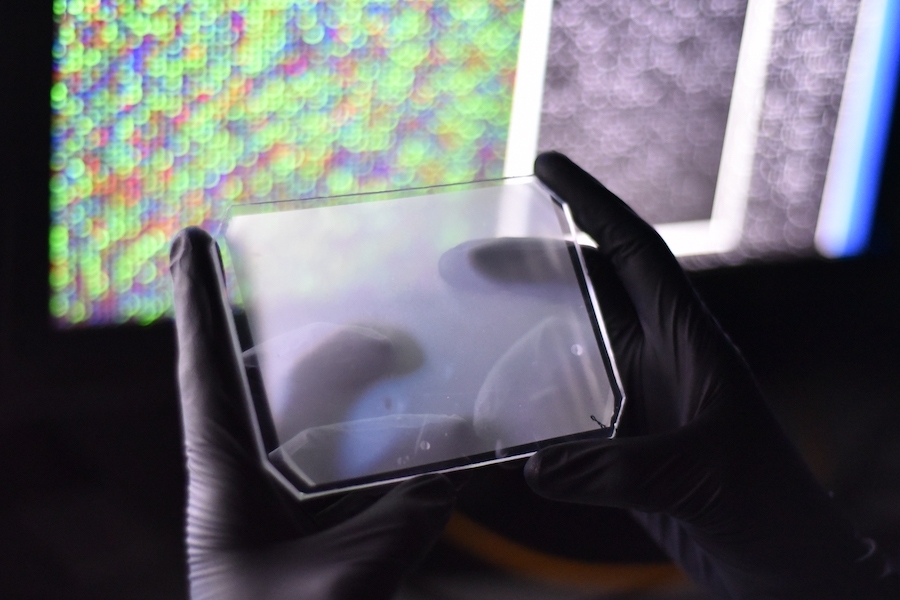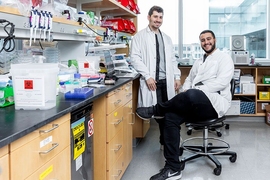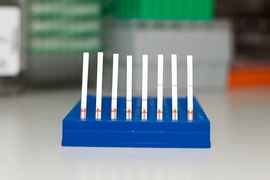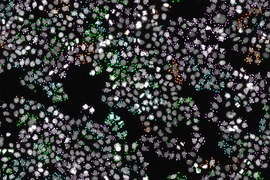The following press release was issued today by the Broad Institute of MIT and Harvard.
Researchers have developed a new technology that flexibly scales up CRISPR-based molecular diagnostics, using microfluidics chips that can run thousands of tests simultaneously. A single chip’s capacity ranges from detecting a single type of virus in more than 1,000 samples at a time to searching a small number of samples for more than 160 different viruses, including the Covid-19 virus.
Called Combinatorial Arrayed Reactions for Multiplexed Evaluation of Nucleic acids (CARMEN), this technology — validated on patient samples — provides same-day results and could someday be harnessed for broad public-health efforts.
The work appears in Nature, led by co-first authors Cheri Ackerman and Cameron Myhrvold, both postdoctoral fellows at the Broad Institute of MIT and Harvard. Paul Blainey, core member of the Broad Institute and associate professor in the Department of Biological Engineering at MIT, and Pardis Sabeti, institute member at Broad, professor at Harvard University, and Howard Hughes Medical Institute Investigator, are co-senior authors.
“The current pandemic has only underscored that rapid and sensitive tools are critical for diagnosing, surveilling, and characterizing an infection within a population,” said Sabeti. “The need for innovative diagnostics that can be applied broadly in communities has never been more urgent.”
“CRISPR-based diagnostics are an attractive tool for their programmability, sensitivity, and ease of use,” said Myhrvold. “Now, with a way to scale up these diagnostics, we can explore their potential for comprehensive approaches — for example, enabling clinicians to see if patients are harboring multiple infections, to rule out a whole panel of diseases very quickly, or to test a large population of patients for a serious infection.”
Miniaturizing CRISPR diagnostics
To build a testing platform with this capacity, the team turned to microfluidics, adapting and improving on technology developed in 2018 by Blainey's lab. The researchers created rubber chips, slightly larger than a smartphone, with tens of thousands of “microwells” — small compartments designed to each hold a pair of nanoliter-sized droplets. One droplet contains viral genetic material from a sample, and the other contains virus-detection reagents.
“The microwell chips are made like a stamp — it's rubber poured over a mold,” explained Ackerman. “We're easily able to replicate and share this technology with collaborators.”
The detection approach used on the chips is adapted from the CRISPR-based diagnostic SHERLOCK, first described in 2017 and developed by team of scientists from the Broad Institute, the McGovern Institute for Brain Research at MIT, the Institute for Medical Engineering & Science at MIT, and the Wyss Institute for Biologically Inspired Engineering at Harvard University.
To use the CARMEN platform, researchers first extract viral RNA from samples and make copies of this genetic material, similar to the preparation process for RT-qPCR diagnostics currently used for suspected COVID-19 cases. The researchers then add a unique fluorescent color dye to each prepared sample and divide the mixture into tiny droplets.
The detection mixtures, on the other hand, contain the CRISPR protein Cas13, a guide RNA that looks for a specific viral sequence, and molecules to report the results. These mixtures are also color-coded and separated into droplets.
Thousands of droplets from the samples and detection mixtures are then pooled together and loaded onto a chip in a single pipetting step. Each microwell in the chip catches two droplets. When a detection droplet finds its target — a specific viral genetic sequence — in a sample droplet in the same microwell, a signal is produced and detected by a fluorescence microscope. The entire protocol, from RNA extraction to results, takes under eight hours.
“Uniting these two technologies in a single platform gives us exciting new capabilities to investigate clinical and epidemiological questions,” said co-author Gowtham Thakku, an MIT graduate student in Broad’s Infectious Disease and Microbiome Program.
CARMEN enables more than 4,500 tests on a single microfluidics chip, which can apply to patient samples in a variety of ways using the available fluorescent codes. For example, a single chip could simultaneously test 1,048 samples for a single virus, or five samples for 169 viruses. The capacity can be easily scaled up further by adding more chips: “We normally run four or five chips in a single day,” noted Ackerman.
Multiplexing capabilities
To showcase the platform's multi-diagnostic capabilities, the team developed a strategy for rapidly testing dozens of samples for the 169 human-associated viruses that have more than 10 published genome sequences. The researchers tested this detection panel against 58 patient samples, using multiple chips. They additionally applied CARMEN on patient samples to differentiate between subtypes of influenza A strains and to detect drug-resistance mutations in HIV.
The team also incorporated detection mixtures for SARS-CoV-2 — the virus that causes Covid-19 — and other respiratory pathogens to demonstrate, using synthetic viral sequences, how the assay can be rapidly adapted to detect emerging viruses.
“CARMEN offers both impressive throughput and flexibility in diagnostic testing,” said co-author Catherine Freije, a Harvard graduate student in the Sabeti lab.
The researchers report that the platform's sensitivity is comparable to previously published SHERLOCK assays, and they are continuing to improve and validate CARMEN using additional clinical samples. Coupled with the successful testing data from patient samples described in Nature today, this approach could be readily translatable in the clinic, according to the team.
“This miniaturized approach to diagnostics is resource-efficient and easy to implement,” said Blainey. “New tools require creativity and innovation, and with these advances in chemistry and microfluidics, we’re enthusiastic about the potential for CARMEN as the community works to beat back both COVID-19 and future infectious disease threats.”
Support for this study was provided in part by Howard Hughes Medical Institute, the Koch Institute for Integrative Cancer-Harvard Cancer Center Research Bridge Project, an MIT Deshpande Center Innovation Award, the Merkin Institute for Transformative Technologies in Healthcare, a Burroughs Wellcome Fund CASI Award, the Defense Advanced Research Projects Agency (DARPA) grant D18AC00006, and the NIH (F32CA236425).


![“The major research directions and technology platforms that [my] lab is known for today came out of this process where the students or I had a crazy idea, and then the lab executed on it, with all the twists and turns along the way,” says Paul Blainey, associate professor of biological engineering.](/sites/default/files/styles/news_article__archive/public/images/201910/MIT-Blainey.jpg?itok=7LpMu_D5)







